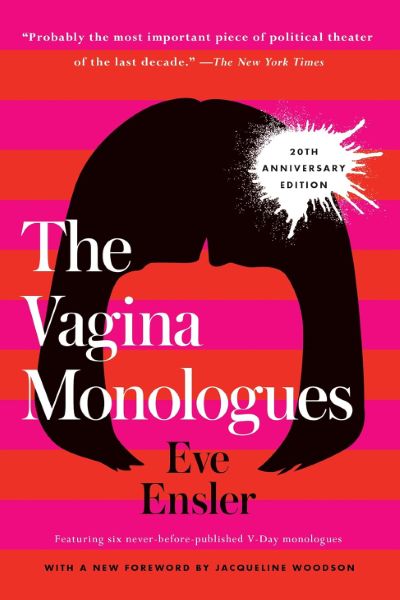The Vagina Monologues
Revolutionary feminist theatrical work that breaks gender taboos through direct expression of women's bodily experiences, laying foundations for global anti-sexual violence movements.

📝 Book Review
In the feminist cultural movement of the 1990s, Eve Ensler’s “The Vagina Monologues” struck like thunder, breaking the silence and taboos surrounding women’s bodies. This revolutionary theatrical work created in 1996 is not merely a literary piece but a catalyst for a global social movement. Through direct naming and discussion of women’s most intimate body parts, Ensler provided millions of women with a platform to express their experiences, traumas, and strength, fundamentally changing how people discuss women’s bodies, sexual violence, and gender rights.
Ensler’s own experiences provided profound personal foundations for this work. As a woman who suffered sexual abuse in childhood, she deeply understood the harm that silence and shame cause to women. She realized that taboos surrounding women’s bodies are not merely cultural issues but political ones—they prevent women from talking about their experiences, both pleasurable and painful, thereby maintaining control and oppression over women’s bodies.
The creation of “The Vagina Monologues” stemmed from her in-depth interviews with over 200 women of different ages, races, and class backgrounds. This extensive field research gave the work strong authenticity and representativeness.
Destigmatizing the Word “Vagina”
“The Vagina Monologues’” most subversive contribution lies in destigmatizing the word “vagina.” In many cultures, women’s sexual organs are either treated with medical coldness or degraded through vulgarity, rarely having opportunities to be discussed with respect and celebration. Through repeatedly using this word and connecting it with women’s wisdom, strength, and experiences, Ensler completely changed the cultural meaning of this vocabulary.
She transformed “vagina” from an avoided taboo word into a symbol of women’s power and autonomy. This linguistic intervention represents one of the work’s most significant political achievements, demonstrating how naming and claiming language can be acts of resistance and empowerment.
The destigmatization process also involved reclaiming women’s right to speak about their own bodies without shame, medical mediation, or male interpretation. By centering women’s own voices and experiences, Ensler challenged systems that silence or distort women’s self-knowledge and self-expression.
Structure Reflecting Women’s Diverse Experiences
This work’s structure embodies the diversity and complexity of women’s experiences. From the angry denunciation of sexual violence in “My Angry Vagina” to the honest exploration of women’s sexual experiences in “The Vagina Interviews,” to the defense of women’s freedom of dress in “My Short Skirt,” each monologue focuses on different aspects of women’s experiences.
This diversified presentation avoids simplifying women’s experiences, acknowledging differences and diversity within women’s groups. The episodic structure also mirrors how women often share experiences in fragments, moments of revelation, and personal testimony rather than linear narratives.
“My Angry Vagina” is possibly the most politically impactful section of the entire work. Through listing various forms of sexual violence and bodily violation, this monologue not only expresses anger but reveals the universality of violent threats that women face daily. This direct and intense expression breaks social expectations that sexual violence victims “should remain silent,” providing women with voices to express anger and resistance.
The anger expressed is not merely personal but collective, representing generations of women’s suppressed rage about violence, violation, and silencing. This cathartic expression validates women’s right to anger while channeling it toward social change.
Exploring the Full Spectrum of Women’s Experiences
“The Flood” explores changes in women’s sexual desire and sexual experiences across different life stages through an elderly woman’s experience. This attention to women’s sexual experiences throughout their entire lives challenges social bias that only focuses on young women’s bodies and sexual experiences. It reminds us that women’s sexual lives and bodily experiences don’t lose value and meaning due to age.
“My Short Skirt” reveals how women’s bodies are disciplined by social gaze through discussion of freedom of dress. The short skirt here is not merely a piece of clothing but a symbol of women’s autonomy. Various social restrictions and expectations about women’s dress actually constitute violations of women’s bodily autonomy. This monologue powerfully counters “victim-blaming” logic, insisting that women have the right to choose their own clothing without being harmed.
“Birth” explores the complexity of women’s birthing experiences. From birth’s joy to pain, from autonomous choice to forced childbearing, this monologue reveals multiple dilemmas women face regarding reproduction. It both celebrates the miracle of women’s bodies creating life and critiques social control over women’s reproductive choices.
Global Anti-Sexual Violence Movement
“The Vagina Monologues’” contribution to the global anti-sexual violence movement is historic. In 1998, Ensler launched the “V-Day” movement, combining this theatrical work with actual anti-violence action. Every February 14th, Valentine’s Day, thousands of performances of “The Vagina Monologues” occur worldwide, with proceeds supporting local anti-sexual violence organizations.
This model combining art with social action created new forms of cultural activism. The V-Day movement has raised millions of dollars for grassroots organizations while raising awareness about violence against women and creating communities of support and resistance.
The global reach of V-Day demonstrates how cultural work can become a vehicle for political organizing, bringing together people across different backgrounds around shared commitments to ending violence and supporting survivors.
Educational Impact and Campus Culture
This work’s influence in education is equally profound. Many universities have incorporated “The Vagina Monologues” into gender studies, literature, and theater curricula, providing students with safe spaces to discuss sensitive topics. Through participating in performances, young women gain opportunities to express their experiences and viewpoints, and this participatory learning approach has deep educational value.
Campus productions often serve as consciousness-raising events, creating opportunities for dialogue about topics that are otherwise difficult to address in academic settings. The collaborative nature of production also builds community among participants while developing leadership skills and political awareness.
The educational impact extends beyond formal academic settings to include community centers, women’s shelters, and other spaces where women gather to share experiences and build solidarity.
Cross-Cultural Adaptation and Global Reach
“The Vagina Monologues’” transmission across different cultural backgrounds demonstrates its universality and adaptability. Although this work originated in American cultural context, it has been translated into 48 languages and performed in over 140 countries. In different cultural contexts, performers adapt content according to local women’s experiences.
This localization process enables the work to truly reflect women’s voices in different cultures while maintaining its core commitment to breaking silence and challenging oppression. Local adaptations have included stories specific to particular regions, languages, and cultural contexts while preserving the work’s essential message about women’s empowerment.
The global adaptability also demonstrates how feminist art can travel across borders while respecting cultural specificity, creating opportunities for international solidarity while honoring local knowledge and experience.
Controversies and Criticisms
However, “The Vagina Monologues” has also faced controversy and criticism. Some critics argue that this work oversimplifies women’s identity, reducing women to sexual organs. Others criticize that it mainly reflects experiences of middle-class white women, lacking sufficient attention to experiences of women of color and transgender women.
These criticisms prompted Ensler to include more diverse voices in subsequent versions, including transgender women’s experiences. The evolution of the work reflects broader developments in feminist theory and activism, particularly increased attention to intersectionality and inclusion.
Contemporary criticisms also address questions about biological essentialism and the exclusion of people without vaginas from definitions of womanhood, leading to ongoing conversations about how feminist art can be both body-positive and trans-inclusive.
Innovation in Theatrical Art
From a theatrical art perspective, “The Vagina Monologues” innovated drama’s form and function. It’s not traditional theater in the conventional sense, lacking complete storylines or complex character development, but instead directly conveying women’s experiences and voices through monologue form.
This form’s simplicity and directness makes it easy to perform in various venues, from large theaters to community centers. The accessibility of the format has been crucial to its global spread and grassroots adoption.
The work also challenged traditional distinctions between performer and audience, encouraging participation and interaction rather than passive consumption of entertainment. This participatory approach aligns with feminist principles of collective action and shared authority.
Language and Discourse Rights
“The Vagina Monologues’” contribution to language and discourse rights is also important. It not only gives women opportunities to speak words usually suppressed but, more importantly, provides women with discourse rights to define their own experiences. For a long time, discourse about women’s bodies and sexual experiences was mainly dominated by men.
The emergence of “The Vagina Monologues” changed this situation, making women narrators of their own experiences. This shift in narrative authority represents a fundamental challenge to patriarchal control over knowledge production and meaning-making about women’s bodies and sexuality.
The work also demonstrates how speaking the unspeakable can be a form of political action, breaking down barriers that maintain oppressive systems through silence and shame.
Therapeutic and Healing Applications
This work has also played important roles in psychotherapy and trauma recovery. Many sexual violence survivors find that watching or participating in performances of “The Vagina Monologues” helps them process their traumatic experiences. Through hearing similar experiences from other women, they feel no longer alone, and this sense of group identification is crucial to the recovery process.
The therapeutic dimensions of the work extend beyond individual healing to community healing, creating spaces where collective trauma can be acknowledged and processed. The public nature of performance also serves to break isolation and create networks of support.
Professional therapists and counselors have incorporated elements from the work into treatment approaches, using performance and storytelling as tools for healing and empowerment.
Popular Culture Impact
“The Vagina Monologues’” influence on popular culture is far-reaching. It brought the word “vagina” into mainstream cultural discussion, influencing various cultural products from television programs to advertisements. Although sometimes this influence might be commercialized or superficialized, it has indeed expanded public discussion space about women’s bodies.
The work’s cultural impact includes inspiring other artists to address previously taboo subjects, influencing fashion and advertising that celebrate rather than shame women’s bodies, and contributing to broader cultural shifts toward body positivity and sexual liberation.
However, the commercialization of some aspects of the work’s message also raises questions about how radical feminist art gets co-opted by capitalist systems, sometimes diluting its political edge.
Legal and Policy Influence
At legal and policy levels, “The Vagina Monologues” and related V-Day movements have also produced practical impacts. They have raised public awareness about sexual violence issues, promoting improvements in related laws and strengthened enforcement. Anti-sexual violence legislation in many countries has been influenced by this movement.
The work has been cited in policy discussions, used as evidence in legislative hearings, and referenced in court cases involving violence against women. Its cultural authority has lent weight to policy arguments about the need for legal protections and support services.
International human rights organizations have also drawn on the work’s documentation of women’s experiences to support arguments for stronger protections for women’s rights globally.
Third Wave Feminist Body Politics
From a feminist theory perspective, “The Vagina Monologues” embodies third-wave feminism’s attention to body politics. It both inherits second-wave feminism’s concern with sexual violence issues and incorporates recognition of diversified women’s experiences. It emphasizes the political nature of personal experience, connecting personal bodily experience with broader political struggle.
The work’s approach to the body as a site of both oppression and resistance reflects third-wave feminist insights about the complexity of women’s relationships to their own embodiment. Rather than viewing the body as simply a victim of patriarchal control, the work presents bodies as sources of knowledge, pleasure, and power.
This body-positive approach has influenced subsequent feminist art and activism, contributing to movements that celebrate rather than shame women’s bodies and sexuality.
Digital Age Adaptations
In the digital age, “The Vagina Monologues” has found new transmission methods. Related discussions on social media platforms, online performances and reading groups, and digitized educational resources have all expanded this work’s influence range. Particularly during the COVID-19 pandemic, online performance formats allowed more people to access this work.
Virtual performances have created new possibilities for participation, allowing people who might not otherwise attend live theater to engage with the work. Digital platforms have also facilitated international connections between performers and audiences, strengthening global networks of feminist solidarity.
Social media campaigns related to the work have helped spread its messages to younger generations while adapting its format for contemporary communication styles.
Contemporary Relevance and #MeToo
Today, “The Vagina Monologues” still has strong contemporary relevance. Against the background of the #MeToo movement, this work from over 20 years ago appears more prescient. It provided women with frameworks and language to express sexual violence experiences ahead of time, laying foundations for later social movements.
The work’s emphasis on believing women’s stories, breaking silence about sexual violence, and centering survivors’ voices directly anticipated strategies that became central to #MeToo activism. Its model of collective testimony and shared experience provided templates for how survivors could support each other.
The ongoing relevance of the work’s core messages demonstrates both how much progress has been made in addressing violence against women and how much work remains to be done.
Evolution and Future Challenges
However, as gender theory develops, “The Vagina Monologues” also faces challenges of keeping pace with the times. How to better include transgender women’s experiences, how to avoid biological essentialism traps, and how to adapt to new social realities while maintaining the original work’s spirit are all current issues requiring consideration.
Contemporary discussions have addressed questions about whether the work’s focus on vaginas excludes trans women without vaginas and includes trans men who have them, leading to revisions and supplementary works that attempt to address these concerns.
The evolution of the work reflects broader developments in feminist thought about intersectionality, inclusion, and the relationship between biological sex and gender identity.
Cultural Globalization Model
From a globalization perspective, “The Vagina Monologues” represents a successful model of cultural globalization. It’s not simple cultural export but provides a framework that can be localized in different cultures. Performers in various countries can fill in content conforming to local culture and women’s experiences within this framework.
This model maintains the work’s core spirit while allowing cultural diversity. The successful adaptation of the work across different cultural contexts demonstrates how feminist art can be both universal and particular, speaking to shared experiences of gender oppression while honoring cultural specificity.
The global success of the work has also facilitated international feminist organizing and consciousness-raising, creating connections between women’s movements in different countries and regions.
Conclusion: Breaking Silence as Liberation
“The Vagina Monologues” reminds us that breaking silence is an important step in women’s liberation. By providing women with safe spaces to share their most intimate experiences, this work not only provides emotional support but creates possibilities for political action. It proves that art can not only reflect reality but change reality.
In the current context where global women’s rights still face challenges, the spirit of “The Vagina Monologues” still has important inspirational significance: only when women can freely discuss their bodies and experiences can true gender equality be achieved.
The work’s lasting legacy lies in its demonstration that speaking truth about women’s experiences, no matter how uncomfortable or challenging, is essential for social transformation. By refusing to accept silence as normal or necessary, “The Vagina Monologues” opened space for all the conversations, movements, and changes that have followed.
Through its revolutionary approach to language, performance, and political action, the work continues to inspire new generations of feminists to break their own silences, tell their own stories, and work for a world where all people can live free from violence and oppression. The thunderclap that began in 1996 continues to reverberate, creating waves of change that extend far beyond any single performance or production.
Discussion
读书讨论
分享您对这本书的感想和看法,与其他读者交流见解
加入讨论
分享您对这本书的感想和看法,与其他读者交流见解
加载评论中...
Book Info
🛒 Get This Book
 Buy on Amazon
Buy on Amazon Related Books
读书讨论
分享您对这本书的感想和看法,与其他读者交流见解
加入讨论
分享您对这本书的感想和看法,与其他读者交流见解
加载评论中...

